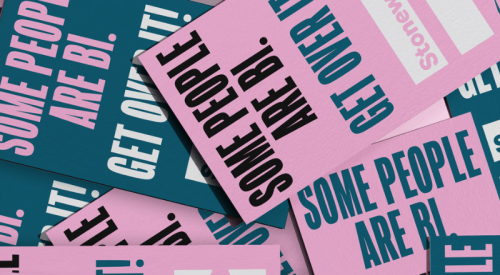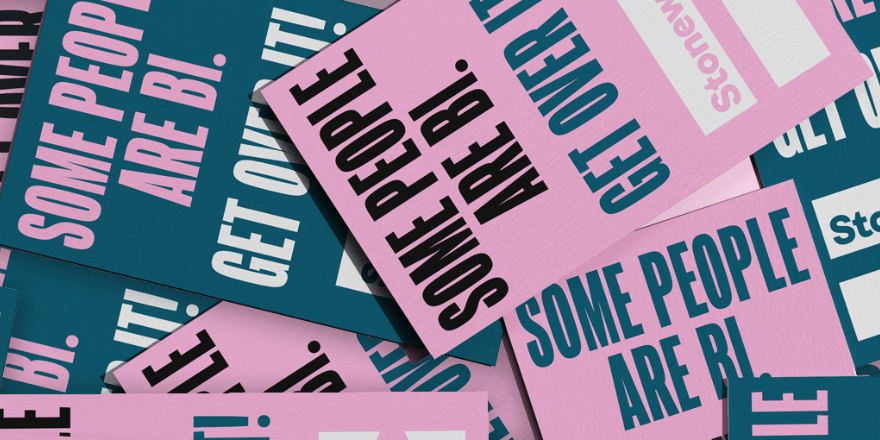
A short history of the word ‘bisexuality’

People have been attracted to more than one gender throughout recorded history. But specific identity labels like bi and pan are relatively new. How did bi+ people in the past understand their identities and attractions, and how does this history affect bi people and communities in the UK today? Our Research Officer Martha Robinson Rhodes, who has a PhD in bi history, explains…
In 1859, anatomist Robert Bentley Todd first used the term ‘bisexuality' to refer to the possession of ‘male’ and ‘female’ physical characteristics in the same body – today, we might understand this as being intersex. This meaning was taken up by nineteenth-century sexologists – scientists and psychologists studying sex and sexuality, including Henry Havelock Ellis and Richard von Krafft-Ebing – who explored evolution and speculated about “the latent organic bi-sexuality in each sex”, noting that “at an early stage of development, the sexes are indistinguishable”.
By the beginning of the twentieth century, this meaning had shifted to focus on a combination of ‘masculine’ and ‘feminine’ gendered characteristics – what today we would describe as androgyny. The modern meaning of bisexuality, which describes sexual and/or romantic attraction rather than sexed or gendered characteristics, only developed in the 1910s. However, for many years the different meanings of bisexuality were used at the same time and sometimes in the same texts. Sigmund Freud made his famous claim about ‘universal’ bisexuality in 1915, but referred to this both as a combination of masculinity and femininity and as a sexual or romantic attraction, writing, “the sexual object is a kind of reflection of the subject’s bisexual nature”.
But if people in the past didn't use the term 'bi', how did people attracted to more than one gender describe themselves?
There is no simple answer to this question. Some didn’t use an identity label at all, preferring not to categorise their relationships. Some understood themselves as heterosexual, while others identified as gay or lesbian. Others described themselves using percentages or ratios, such as ‘60:40 gay:heterosexual’. When the term ‘gay’ was first popularised by gay liberationists in the 1970s, it often linked radical politics and same-gender attraction, but didn’t necessarily exclude people who were attracted to, or had relationships with, multiple genders.
One interviewee I spoke to during my PhD recalled: “There was a general understanding that sexuality was some sort of spectrum, and that people would move along it from time to time”. It’s also important to note that this terminology is particular to English-speakers in the West, and that elsewhere in the world there has been a diverse range of approaches to sexuality and gender that often reject binary categorisations. In many cases, these approaches have been restricted or prohibited as a legacy of colonialism.
It wasn’t until the late 1970s that the current understanding of bisexuality, as an orientation or capacity for attraction, became widely accepted in the UK as "the more common usage". Around this point, we started to see bi groups and events being established. The UK’s first bi group, London Bisexual Group, was formed in 1981, followed by other groups in Edinburgh (1984), Brighton (1985), Manchester (1986) and Glasgow (1988), as well as a London-based Bisexual Women’s Group. A magazine, Bi-Monthly, was founded, as well as two bi helplines in London and Edinburgh, and the UK’s longest continually-running LGBTQ+ community event, the annual BiCon.
Bi terminology and politics have continued to evolve since the 1980s. While definitions of bisexuality initially focused on attractions to ‘both’ genders, over time it became more common to refer to ‘attraction to more than one gender’. The term ‘pansexual’ became popular in the 1990s in response to concerns about bisexuality upholding the gender binary, using the prefix ‘pan’ (‘all’) to suggest attraction that is not limited by gender. But this doesn’t mean that bi people are therefore only attracted to two genders. Some people attracted to more than one gender identify as both bi and pan, some as one or the other, and some as neither. The 1990 manifesto of Anything that Moves, a US bi magazine, explicitly stated that bisexuality shouldn’t be understood as binary: “Do not assume that bisexuality is binary or duogamous in nature: that we have “two” sides or that we must be involved simultaneously with both genders to be fulfilled human beings. In fact, don’t assume that there are only two genders”.
Today, we still see the complex history of bisexuality and the shifting use of language being used to erase bi people’s identities, or suggest that they are a ‘phase’. This has hugely damaging effects on bi people and communities. Stonewall’s Bi Report shows that bi people often report not feeling welcome in LGBTQ+ spaces, and experience much higher rates of discrimination from within the LGBTQ+ community. 43% of bi people have never attended an LGBTQ+ space or event, compared to 29% of gay men and lesbians. Research also indicates that bi people are also more likely to experience poor mental health, in part because of this erasure and discrimination.
Changing language should never be used as an excuse to dismiss or reject bi or pan people’s identities and attractions. One of my interviewees summed this up as: “Language evolves. September isn’t the seventh month. October isn’t the eighth month. Bisexual doesn’t mean two genders”.
Instead, understanding how language and communities have evolved reminds us that there is exciting potential for further change and progress in the future, towards greater equality for bi people and other LGBTQ+ people. For me, exploring and understanding this change is what makes learning about our history so important – in LGBT+ History Month, and all year round.
References and further reading
- Bi Academic Intervention (ed), The Bisexual Imaginary: Representation, Identity and Desire (1997)
- Shiri Eisner, Bi: Notes for a Bisexual Revolution (2013)
- Sigmund Freud translated by James Strachey, Three Essays on the Theory of Sexuality: 1. The Sexual Aberrations (1915 edition)
- Kate Harrad (ed), Purple Prose: Bisexuality in Britain (2016)
- Henry Havelock Ellis, Studies in the Psychology of Sex Volume I: Sexual Inversion (1897)
- Clare Hemmings, Bisexual Spaces: A Geography of Sexuality and Gender (2002)
- Lachlan MacDowall, ‘Historicising Contemporary Bisexuality’, Journal of Bisexuality (2009)
- The Off Pink Collective (ed), Bisexual Horizons: Politics, Histories, Lives (1996)
- Paula C. Rust, Bisexuality and the Challenge to Lesbian Politics (1995)
- Martha Robinson Rhodes, ‘Bisexuality, Multiple-Gender-Attraction and Gay Liberation Politics in the 1970s’ (2020)
- Merl Storr (ed), Bisexuality: A Critical Reader (1999)
- Naomi Tucker (ed), Bisexual Politics: Theories, Queries and Visions (1995)
This article was updated 13/06/2022 to add further detail about the modern meaning of bisexuality.